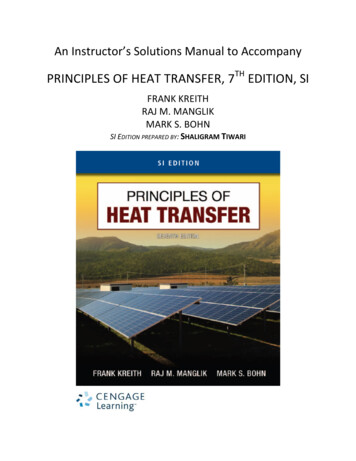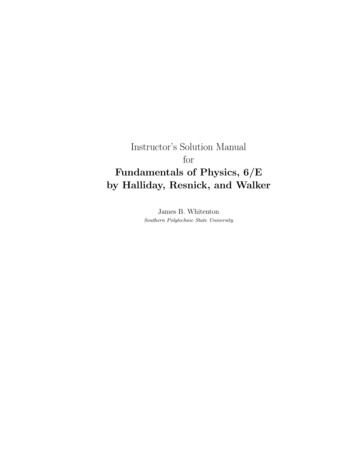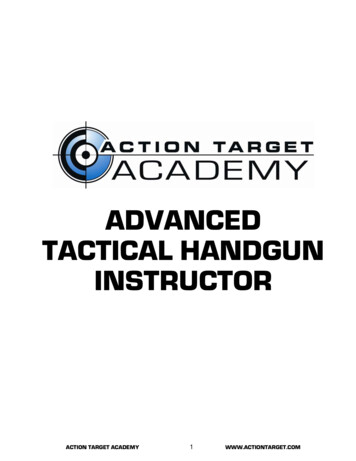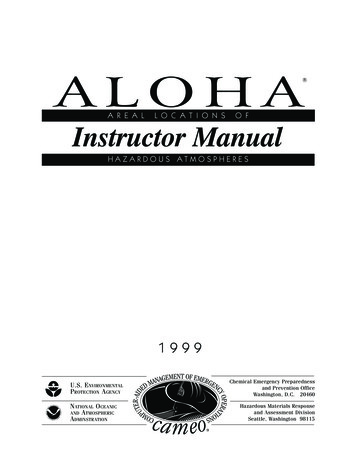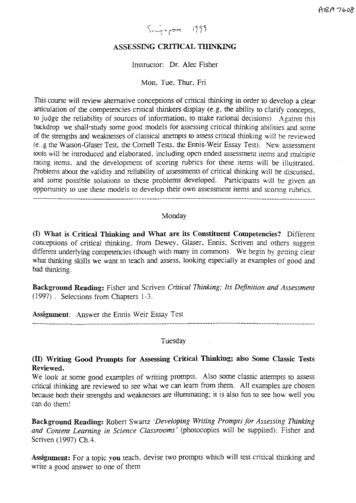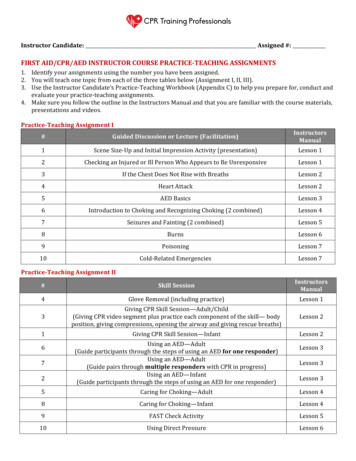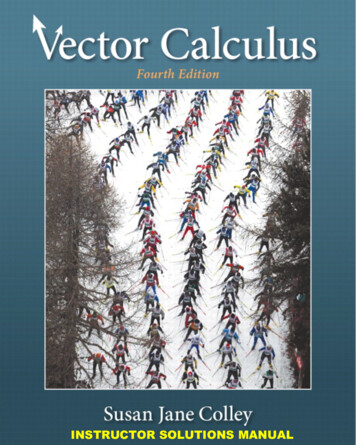
Transcription
INSTRUCTOR SOLUTIONS MANUAL
INSTRUCTOR’S SOLUTIONSMANUALSUSAN JANE COLLEYDANIEL H. STEINBERGV ECTOR C ALCULUSFOURTH EDITIONSusan Jane ColleyOberlin CollegeBoston Columbus Indianapolis New York San Francisco Upper Saddle RiverAmsterdam Cape Town Dubai London Madrid Milan Munich Paris Montreal TorontoDelhi Mexico City Sao Paulo Sydney Hong Kong Seoul Singapore Taipei Tokyo
The author and publisher of this book have used their best efforts in preparing this book. These efforts include thedevelopment, research, and testing of the theories and programs to determine their effectiveness. The author andpublisher make no warranty of any kind, expressed or implied, with regard to these programs or the documentationcontained in this book. The author and publisher shall not be liable in any event for incidental or consequentialdamages in connection with, or arising out of, the furnishing, performance, or use of these programs.Reproduced by Pearson from electronic files supplied by the author.Copyright 2012, 2006, 2002 Pearson Education, Inc.Publishing as Pearson, 75 Arlington Street, Boston, MA 02116.All rights reserved. No part of this publication may be reproduced, stored in a retrieval system, or transmitted, in anyform or by any means, electronic, mechanical, photocopying, recording, or otherwise, without the prior writtenpermission of the publisher. Printed in the United States of America.ISBN-13: 978-0-321-78066-9ISBN-10: 0-321-78066-3www.pearsonhighered.com
Table of ContentsChapter 1 Vectors1.11.21.31.41.51.61.7Vectors in Two and Three DimensionsMore About VectorsThe Dot ProductThe Cross ProductEquations for Planes; Distance ProblemsSome n-dimensional GeometryNew Coordinate SystemsTrue/False Exercises for Chapter 1Miscellaneous Exercises for Chapter 11712172633445455Chapter 2 Differentiation in Several Variables2.12.22.32.42.52.62.7Functions of Several Variables; Graphing SurfacesLimitsThe DerivativeProperties; Higher-order Partial DerivativesThe Chain RuleDirectional DerivativesNewton’s MethodTrue/False Exercises for Chapter 2Miscellaneous Exercises for Chapter 2758593102113124132138138Chapter 3 Vector-Valued Functions3.13.23.33.4Parametrized Curves and Kepler’s LawsArclength and Differential GeometryVector Fields: An IntroductionGradient, Divergence, Curl and the Del OperatorTrue/False Exercises for Chapter 3Miscellaneous Exercises for Chapter 3149159168177184185Chapter 4 Maxima and Minima in Several Variables4.14.24.34.4Differentials and Taylor’s TheoremExtrema of FunctionsLagrange MultipliersSome Applications of ExtremaTrue/False Exercises for Chapter 4Miscellaneous Exercises for Chapter 4 2012, Pearson Education, Inc.195205216228233233
Chapter 5 Multiple Integration5.15.25.35.45.55.65.7Introduction: Areas and VolumesDouble IntegralsChanging the Order of IntegrationTriple IntegralsChange of VariablesApplications of IntegrationNumerical Approximations of Multiple IntegralsTrue/False Exercises for Chapter 5Miscellaneous Exercises for Chapter 5245247262270280291304315316Chapter 6 Line Integrals6.1 Scalar and Vector Line Integrals6.2 Green’s Theorem6.3 Conservative Vector FieldsTrue/False Exercises for Chapter 6Miscellaneous Exercises for Chapter 6337344356361361Chapter 7 Surface Integrals and Vector Analysis7.17.27.37.4Parametrized SurfacesSurface IntegralsStokes’s and Gauss’s TheoremsFurther Vector Analysis; Maxwell’s EquationsTrue/False Exercises for Chapter 7Miscellaneous Exercises for Chapter 7375384394413420420Chapter 8 Vector Analysis in Higher Dimensions8.1 An Introduction to Differential Forms8.2 Manifolds and Integrals of k-forms8.3 The Generalized Stokes’s TheoremTrue/False Exercises for Chapter 8Miscellaneous Exercises for Chapter 8 2012, Pearson Education, Inc.439444449454454
Chapter 1Vectors1.1 Vectors in Two and Three Dimensions1. Here we just connect the point (0, 0) to the points indicated:y3b2.52c1.5a10.5-1123x2. Although more difficult for students to represent this on paper, the figures should look something like the following. Note thatthe origin is not at a corner of the frame box but is at the tails of the three vectors.3za2b1c200-2-202yxIn problems 3 and 4, we supply more detail than is necessary to stress to students what properties are being used:3. (a) (3, 1) ( 1, 7) (3 [ 1], 1 7) (2, 8).(b) 2(8, 12) ( 2 · 8, 2 · 12) ( 16, 24).(c) (8, 9) 3( 1, 2) (8 3( 1), 9 3(2)) (5, 15).(d) (1, 1) 5(2, 6) 3(10, 2) (1 5 · 2 3 · 10, 1 5 · 6 3 · 2) ( 19, 25).(e) (8, 10) 3((8, 2) 2(4, 5)) (8 3(8 2 · 4), 10 3( 2 2 · 5)) (8, 26).4. (a) (2, 1, 2) ( 3, 10, 9). 9, 7) (2 3, 1 9, 2 7) ( 1,(b) 12 (8, 4, 1) 2 5, 7, 14 4, 2, 12 10, 14, 12 (14, 12, 1).(c) 2 (2, 0, 1) 6 12 , 4, 1 2((2, 0, 1) (3, 24, 6)) 2( 1, 24, 5) (2, 48, 10).5. We start with the two vectors a and b. We can complete the parallelogram as in the figure on the left. The vector from theorigin to this new vertex is the vector a b. In the figure on the right we have translated vector b so that its tail is the head ofvector a. The sum a b is the directed third side of this triangle.c 2012 Pearson Education, Inc.1
2Chapter 1Vectorsyy776a b6a b5 b translated54b4b3322a11-2-1.5-1-0.56. a (3, 2) b ( 1, 1)a b (3 ( 1), 2 1) (4, 1)a0.51a2 x1 32 ,1-2-1.5-1-0.5a 2b (1, 4)y4a 2b3a2-2a-b1b(1/2)a-112543-1 7. (a) AB ( 3 1, 3 0, 1 2) ( 4, 3, 1) BA AB (4, 3, 1) (b) AC (2 1, 1 0, 5 2) (1, 1, 3) BC (2 ( 3), 1 3, 5 1) (5, 2, 4) AC CB (1, 1, 3) (5, 2, 4) ( 4, 3, 1)(c) This result is true in general:BACHead-to-tail addition demonstrates this.c 2012 Pearson Education, Inc.x0.51x
Section 1.1. Vectors in Two and Three Dimensions38. The vectors a (1, 2, 1), b (0, 2, 3) and a b (1, 2, 1) (0, 2, 3) (1, 0, 4) are graphed below. Again note thatthe origin is at the tails of the vectors in the figure.Also, 1(1, 2, 1) ( 1, 2, 1). This would be pictured by drawing the vector (1, 2, 1) in the opposite direction.Finally, 4(1, 2, 1) (4, 8, 4) which is four times vector a and so is vector a stretched four times as long in the same direction.4ba bz2a0-21 0x02y9. Since the sum on the left must equal the vector on the right componentwise: 12 x 2, 9 7 y, and z 3 5. Therefore, x 14, y 16, and z 8.10. If we drop a perpendicularfrom (3, 1) to the x-axis we see that by the Pythagorean Theorem the length of the vector (3, 1) 32 12 10.y10.80.60.40.2x0.511.522.5311. Notice that b (represented by the dotted line) 5a (represented by the solid line).y10b8642ax1c 2342012 Pearson Education, Inc.5
4Chapter 1Vectors12. Here the picture has been projected into two dimensions so that you can more clearly see that a (represented by the solidline) 2b (represented by the dotted line).8a642-4-6-8-242-2b-413. The natural extension to higher dimensions is that we still add componentwise and that multiplying a scalar by a vector meansthat we multiply each component of the vector by the scalar. In symbols this means that:a b (a1 , a2 , . . . , an ) (b1 , b2 , . . . , bn ) (a1 b1 , a2 b2 , . . . , an bn ) and ka (ka1 , ka2 , . . . , kan ).In our particular examples, (1, 2, 3, 4) (5, 1, 2, 0) (6, 1, 5, 4), and 2(7, 6, 3, 1) (14, 12, 6, 2).14. The diagrams for parts (a), (b) and (c) are similar to Figure 1.12 from the text. The displacement vectors are:(a) (1, 1, 5)(b) ( 1, 2, 3)(c) (1, 2, 3)(d) ( 1, 2)Note: The displacement vectors for (b) and (c) are the same but in opposite directions (i.e., one is the negative of theother). The displacement vector in the diagram for (d) is represented by the solid line in the figure -115. In general, we would define the displacement vector from (a1 , a2 , . . . , an ) to (b1 , b2 , . . . , bn ) to be (b1 a1 , b2 a2 , . . . , bn an ).In this specific problem the displacement vector from P1 to P2 is (1, 4, 1, 1). 16. Let B have coordinates (x, y, z). Then AB (x 2, y 5, z 6) (12, 3, 7) so x 14, y 2, z 1 so B hascoordinates (14, 2, 1).17. If a is your displacement vector from the Empire State Building and b your friend’s, then the displacement vector from youto your friend is b a.c 2012 Pearson Education, Inc.
Section 1.1. Vectors in Two and Three Dimensions5youab-aEmpire State Bldgbfriend18. Property 2 follows immediately from the associative property of the reals:(a b) c ((a1 , a2 , a3 ) (b1 , b2 , b3 )) (c1 , c2 , c3 ) ((a1 b1 , a2 b2 , a3 b3 ) (c1 , c2 , c3 ) ((a1 b1 ) c1 , (a2 b2 ) c2 , (a3 b3 ) c3 ) (a1 (b1 c1 ), a2 (b2 c2 ), a3 (b3 c3 )) (a1 , a2 , a3 ) ((b1 c1 ), (b2 c2 ), (b3 c3 )) a (b c).Property 3 also follows from the corresponding componentwise observation:a 0 (a1 0, a2 0, a3 0) (a1 , a2 , a3 ) a.19. We provide the proofs for R3 :(1) (k l)a (k l)(a1 , a2 , a3 ) ((k l)a1 , (k l)a2 , (k l)a3 ) (ka1 la1 , ka2 la2 , ka3 la3 ) ka la.(2) k(a b) k((a1 , a2 , a3 ) (b1 , b2 , b3 )) k(a1 b1 , a2 b2 , a3 b3 ) (k(a1 b1 ), k(a2 b2 ), k(a3 b3 )) (ka1 kb1 , ka2 kb2 , ka3 kb3 ) (ka1 , ka2 , ka3 ) (kb1 , kb2 , kb3 ) ka kb.(3) k(la) k(l(a1 , a2 , a3 )) k(la1 , la2 , la3 ) (kla1 , kla2 , kla3 ) (lka1 , lka2 , lka3 ) l(ka1 , ka2 , ka3 ) l(ka).20. (a) 0a is the zero vector. For example, in R3 :0a 0(a1 , a2 , a3 ) (0 · a1 , 0 · a2 , 0 · a3 ) (0, 0, 0).(b) 1a a. Again in R3 :1a 1(a1 , a2 , a3 ) (1 · a1 , 1 · a2 , 1 · a3 ) (a1 , a2 , a3 ) a.21. (a) The head of the vector sa is on the x-axis between 0 and 2. Similarly the head of the vector tb lies somewhere on thevector b. Using the head-to-tail method, sa tb is the result of translating the vector tb, in this case, to the right by 2s(represented in the figure by tb*). The result is clearly inside the parallelogram determined by a and b (and is only on theboundary of the parallelogram if either t or s is 0 or 1.bxtbtb*saac 2012 Pearson Education, Inc.
6Chapter 1Vectors(b) Again the vectors a and b will determine a parallelogram (with vertices at the origin, and at the heads of a, b, and a b.The vectors sa tb will be the position vectors for all points in that parallelogram determined by (2, 2, 1) and (0, 3, 2). 22. Here we are translating the situation in Exercise 21 by the vector OP0 . The vectors will all be of the form OP0 sa tb for0 s, t 1. 23. (a) The speed of the flea is the length of the velocity vector ( 1)2 ( 2)2 5 units per minute.(b) After 3 minutes the flea is at (3, 2) 3( 1, 2) (0, 4).(c) We solve (3, 2) t( 1, 2) ( 4, 12) for t and get that t 7 minutes. Note that both 3 7 4 and 2 14 12.(d) We can see this algebraically or geometrically: Solving the x part of (3, 2) t( 1, 2) ( 13, 27) we get thatt 16. But when t 16, y 30 not 27. Also in the figure below we see the path taken by the flea will miss thepoint ( 13, 27).y3,2-15 -12.5 -10-7.5-5-2.52.55x-5-10-15-20-13,-27-25-3024. (a) The plane is climbing at a rate of 4 miles per hour.(b) To make sure that the axes are oriented so that the plane passes over the building, the positive x direction is east and thepositive y direction is north. Then we are heading east at a rate of 50 miles per hour at the same time we’re heading northat a rate of 100 miles per hour. We are directly over the skyscraper in 1/10 of an hour or 6 minutes.(c) Using our answer in (b), we have traveled for 1/10 of an hour and so we’ve climbed 4/10 of a mile or 2112 feet. The planeis 2112 1250 or 862 feet about the skyscraper.25. (a) Adding we get: F1 F2 (2, 7, 1) (3, 2, 5) (5, 5, 4).(b) You need a force of the same magnitude in the opposite direction, so F3 (5, 5, 4) ( 5, 5, 4).26. (a) Measuring the force in pounds we get (0, 0, 50).(b) The z components of the two vectors along the ropes must be equal and their sum must be opposite of the z componentin part (a). Their y components must also be opposite each other. Since the vector points in the direction (0, 2, 1),the y component will be twice the z component. Together this means that the vector in the direction of (0, 2, 1) is(0, 50, 25) and the vector in the direction (0, 2, 1) is (0, 50, 25).27. The force F due to gravity on the weight is given by F (0, 0, 10). The forces along the ropes are each parallel to thedisplacement vectors from the weight to the respective anchor points. That is, the tension vectors along the ropes areF1 k((3, 0, 4) (1, 2, 3)) k(2, 2, 1)F2 l((0, 3, 5) (1, 2, 3)) l( 1, 1, 2),where k and l are appropriate scalars. For the weight to remain in equilibrium, we must have F1 F2 F 0, or, equivalently,thatk(2, 2, 1) l( 1, 1, 2) (0, 0, 10) (0, 0, 0).Taking components, we obtain a system of three equations: 2k l 0 2k l 0 k 2l 10.Solving, we find that k 2 and l 4, so thatF1 (4, 4, 2) and F2 ( 4, 4, 8).c 2012 Pearson Education, Inc.
Section 1.2. More about Vectors71.2 More about VectorsIt may be useful to point out that the answers to Exercises 1 and 5 are the “same”, but that in Exercise 1, i (1, 0) and in Exercise5, i (1, 0, 0). This comes up when going the other direction in Exercises 9 and 10. In other words, it’s not always clear whetherthe exercise “lives” in R2 or R3 .1. (2, 4) 2(1, 0) 4(0, 1) 2i 4j.2. (9, 6) 9(1, 0) 6(0, 1) 9i 6j.3. (3, π, 7) 3(1, 0, 0) π(0, 1, 0) 7(0, 0, 1) 3i πj 7k.4. ( 1, 2, 5) 1(1, 0, 0) 2(0, 1, 0) 5(0, 0, 1) i 2j 5k.5. (2, 4, 0) 2(1, 0, 0) 4(0, 1, 0) 2i 4j.6. i j 3k (1, 0, 0) (0, 1, 0) 3(0, 0, 1) (1, 1, 3). 7. 9i 2j 2k 9(1, 0, 0) 2(0, 1, 0) 2(0, 0, 1) (9, 2, 2).8. 3(2i 7k) 6i 21k 6(1, 0, 0) 21(0, 0, 1) ( 6, 0, 21).9. πi j π(1, 0) (0, 1) (π, 1).10. πi j π(1, 0,
INSTRUCTOR SOLUTIONS MANUAL. Boston Columbus Indianapolis New York San Francisco Upper Saddle River Amsterdam Cape Town Dubai London Madrid Milan Munich Paris Montreal Toronto Delhi Mexico City Sao Paulo Sydney Hong Kong Seoul Singapore Taipei Tokyo INSTRUCTOR’S SOLUTIONS MANUAL SUSAN JANE COLLEY DANIEL H. STEINBERG VECTOR CALCULUS FOURTH EDITION
